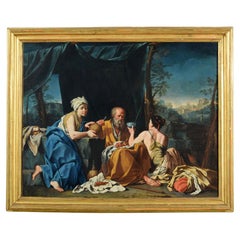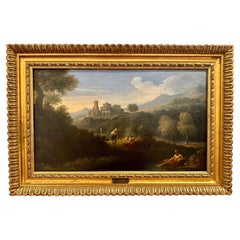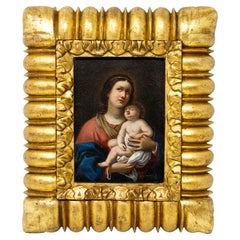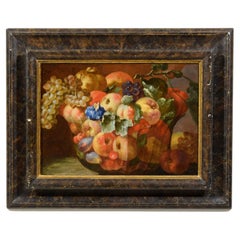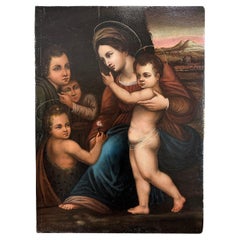18th Century and Earlier Paintings
to
152
750
490
1,323
Height
to
Width
to
287
57
40
33
33
24
8
4
2
2
1,323
3,678
12,836
2,742
1,710
4,675
4,162
185
111
325
479
419
656
1,102
1,141
642
531
751
701
456
401
147
1,059
428
211
106
89
1,323
1,323
1,323
17
4
2
2
1
Period: 18th Century and Earlier
18th Cent., Italian Painting, Loth and the daughters, att. to Giuseppe Gambarini
Located in IT
Giuseppe Gambarini (Bologna, 17 March 1680 - Casalecchio di Reno, 11 September 1725)
Loth and the daughters
Oil on canvas; Measurements: cm H 73 x W 93; frame H 88 x W 108 x D 5,5
The painting, of beautiful pictorial quality, depicts the biblical scene of Lot and his daughters, with Sodom set on fire in the background, and is stylistically attributable to the italian painter Giuseppe Gambarini (Italy, Bologna, 17 March 1680 - Casalecchio di Reno, 11 September 1725).
The canvas shows in the center Lot sitting and already drunk, depicted according to traditional iconography, old, gray and with long gray boat. With his left hand he grabs the wine flask that one of his daughters offers him. She is depicted kneeling and resting on large boulders of stone, described as an architectural base, dressed in a voluminous deep blue mantle, her hair covered with a humble headdress made of a knotted cloth; look at the viewer, as if to want to involve him directly in the scene. The other daughter is described on the left, from the back to the observer, with a bare back and dark hair gathered by a red ribbon. She too is intent on serving her father a cup in which to pour the wine. Around them a duck placed on a cloth, some bread and another wine flask enrich the composition describing a banquet in progress. The scene is set outdoors, where only a large tent supported by branches arranged in a hut serves as a shelter to the figures. In the background a forest landscape blends chromatically with the blue sky. To the right in the distance, is described the city of Sodom, already destroyed and on fire. Lot’s wife...
Category
Italian Baroque Antique 18th Century and Earlier Paintings
Materials
Canvas
$21,738 Sale Price
20% Off
Jan Frans van Bloemen called Orizzonte (Antwerp 1662-Rome 1749), Roman Landscape
Located in CH
Jan Frans van Bloemen called Orizzonte (Antwerp 1662-Rome 1749).
A Late 17th early 18th century Italian landscape with figures of the Roman Campagna.
...
Category
Dutch Baroque Antique 18th Century and Earlier Paintings
Materials
Canvas
Roman school, 17th century, Madonna and Child
Located in Milan, IT
Roman School, 17th century
Madonna and Child
Oil on copper, 15 x 11 cm
Framed, 26 x 22 cm
The small copper on display here depicts the Madonna and Child against a dark background...
Category
Italian Other Antique 18th Century and Earlier Paintings
Materials
Copper
18th Century Spanish Oil Painting of Mary Magdalene
Located in Round Top, TX
A breathtaking 18th century Spanish oil on canvas painting of Mary Magdalene - Madeleine - in is original frame. Beautiful detail.
Category
Spanish Antique 18th Century and Earlier Paintings
Materials
Canvas
18th Century, Italian Painting Still Life by Giovanni Paolo Castelli Lo Spadino
Located in IT
Giovanni Paolo Castelli, known as "Lo Spadino" (Rome 1659 – around 1730)
Still Life with a Composition of Fruit
Dimensions: frame cm L 76.5 x H 61 x D 6.5. Canvas cm L 55.5 x H 40
Th...
Category
Italian Baroque Antique 18th Century and Earlier Paintings
Materials
Canvas, Wood
LATE 16th CENTURY OIL PAINTING ON PANEL MADONNA WITH JESUS AND JOHN
Located in Firenze, FI
Beautiful oil painting on wooden catwood panel. The painting has an almost Leonardesque background, characterized by a temple and distant mountains that recall the Holy Land. In the ...
Category
Italian Renaissance Antique 18th Century and Earlier Paintings
Materials
Wood, Paint
Christ with bonds, Venetian work from the second half of the 15th century
Located in PARIS, FR
Venetian work, second half of the 15th century
Tempera on panel
34 x 23 cm
An episode from the Passion of Christ during the trial of Pontius Pilate, the Roman procurator, concerning ...
Category
Italian Renaissance Antique 18th Century and Earlier Paintings
Materials
Wood
Pair Of French Paintings Landscapes On Enamel 18th Century
Located in Milano, MI
Pair of miniature paintings with bucolic landscapes and figures in shades of blue, two Enamel plates painted with landscapes with figures within gilded frames, of European and probab...
Category
French Neoclassical Revival Antique 18th Century and Earlier Paintings
Materials
Copper, Enamel
A Large Portrait Of A Young Nobleman 18th Century British Oil Painting
Located in London, GB
A Large and sensitively rendered and highly decorative 18th portrait of a dashing young gentleman He wears a long powdered wig and an extravagant costume which includes an electric ...
Category
British Antique 18th Century and Earlier Paintings
Materials
Canvas
Korean Painting, Wall Panel, 17th Century Ink Grapevine
Located in Kyoto, JP
Grapevine
Anonymous. Korean, 17th century.
Wall panel, ink on paper.
Upper seal:
Kou Kinun in
Lower seal:
Kaigen
Dimensions:
Measures: 98.5 cm x 29.5 cm (39” ...
Category
Korean Other Antique 18th Century and Earlier Paintings
Materials
Wood, Paper
Japanese Painting, Framed Panel, 17th Century Falcon by Mitani Toshuku
Located in Kyoto, JP
Mitani Toshuku (1577-1654)
“Falcon”
Wall panel, ink and light color on paper.
Upper seal: Mitani
Lower seal: Toshuku
Dimensions:
Each 118.5 cm x 51 cm x 2 cm (46.5” x 20” x .75”)
Individual falcon paintings by Mitani Toshuku (1577-1654), an early artist of the Unkoku School. Founded by Unkoku Togan (1547–1618), a master of the Momoyama period, the Unkoku school enjoyed long lasting patronage in southern Japan. Togan was a retainer of the Mori family in present day Yamaguchi prefecture. Members of the school considered themselves to be in the artistic lineage of Sesshu Toyo...
Category
Japanese Edo Antique 18th Century and Earlier Paintings
Materials
Wood, Paper
French Louis XVI Young Woman Portrait
Located in Queens, NY
French Louis XVI (18/19th Cent) portrait oil painting of young woman wearing a blue dress holding a pink ribbon with flowers in her hair in a gold carved frame (style of NATTIER)
Category
French Louis XVI Antique 18th Century and Earlier Paintings
Materials
Gold
17th Century Oil on Canvas Still Life Painting, in a 19th Century Giltwood Fram
Located in West Palm Beach, FL
An exceptional Continental late 17th century oil on canvas still life painting, in a 19th century giltwood frame. The beautiful painting displays a wonderful array of vivid colors an...
Category
Unknown Antique 18th Century and Earlier Paintings
Materials
Canvas, Giltwood
18th Century Large Oil on Canvas Italian Painting of King's Daughter, "Europe"
Located in Round Top, TX
Large Original oil on canvas painting of a scene with the king's daughter “Europe”. Unsigned. Inscribed S. Evropæa.
Italian painter, circa late 1700:'s. This painting stands over 6' ...
Category
Italian Antique 18th Century and Earlier Paintings
Materials
Canvas, Wood, Paint
Antique French Pair of large Oils on Canvas Painting of Cherubs 18eme Century
Located in Auribeau sur Siagne, FR
This is an Pair of oil Paintings in the Style of François Boucher.
This is a charming 18th century Pair of oil on canvas painting depicting cherubs . The cherubs are draped.
This...
Category
French Antique 18th Century and Earlier Paintings
Materials
Canvas, Wood, Paper
$7,561 Sale Price / set
20% Off
Oil on Canvas, Roman Follower of Paolo Anesi, Landscape with Milvio Bridge
Located in IT
Roman School, follower of Paolo Anesi, Roman Landscape with the Milvio Bridge, Half of the 18th Century
Oil on canvas, measures: frame cm W 149 x H 112 x D...
Category
Italian Louis XV Antique 18th Century and Earlier Paintings
Materials
Canvas
18th Century French Port Scene Oil Painting from Provence
Located in Dallas, TX
Sharing similarities of a mid-17th-century Italian capriccio painting, this French oil painting from Provence depicts fantastical architecture set amongst the more realistic setting ...
Category
French Antique 18th Century and Earlier Paintings
Materials
Canvas, Wood, Giltwood, Paint
The Assumption of Mary or Dormition of the Virgin 18th Century Spanish Colonial
Located in Rio De Janeiro, BR
This magnificent 18th-century Spanish Colonial oil painting is a remarkable example of religious art, showcasing a stunning depiction of the Dormition of the Virgin. Measuring grandl...
Category
Peruvian Spanish Colonial Antique 18th Century and Earlier Paintings
Materials
Canvas
Antique Indo Persian Illustrated Manuscript of an Elephant
Located in Palm Beach, FL
Charming 18th Century illustrated manuscript of an elephant with passengers executed in gouache on paper on the front and exposed manuscript on the back. Presented in a gold tone woo...
Category
Indian Anglo-Indian Antique 18th Century and Earlier Paintings
Materials
Paint
18th Century Oil on Canvas Italian Painting Landscape with Wayfarers, 1750
Located in Vicoforte, Piedmont
Antique Italian painting from the 18th century. Artwork oil on canvas depicting landscape with pilgrims of a religious nature, scene under study, of good pictorial quality. Beautiful...
Category
Italian Antique 18th Century and Earlier Paintings
Materials
Canvas
Early 18th-Century Baroque Portrait of a Nobleman
Located in 263-0031, JP
An oil-on-canvas full-scale portrait of a standing man in costume typical of the Baroque era of c. 1720, France. Purchased from a dealer in Geneva, Switzerland. The canvas is in good...
Category
French Antique 18th Century and Earlier Paintings
Materials
Canvas
Italian Landscape in the Manner of Vernet
Located in Greenwich, CT
18th century oil on canvas of a Mediterranean harbor scene, in the manner of Claude Vernet (1714-1789) depicting a fanciful scene with castles and villas...
Category
Italian Rococo Antique 18th Century and Earlier Paintings
Materials
Canvas, Giltwood, Paint
Mantuan school, 18th century, Madonna suckling the Child
Located in Milan, IT
Mantuan school, 18th century
Madonna suckling the Child
Oil on panel, 27.5x22 cm
The softly collected and intimate dimension suggested by the present painting underscores the cert...
Category
Italian Other Antique 18th Century and Earlier Paintings
Materials
Wood
A late 18th Century Italian Painting
Located in Hudson, NY
This lovely and decorative painting of peasants in a bucolic setting with numerous farm animals is typical of the period and is designed to illustrate happier moments and a getting b...
Category
Italian Antique 18th Century and Earlier Paintings
Materials
Canvas, Wood
Spanish School Early 17th Century Oil Painting of Christ and the Virgin Mary
Located in CA, CA
An early 17th century painting in oil on canvas from the Spanish School depicting the Lamentation of Christ.
In this moving depiction of the Lamentation Christ...
Category
Spanish Renaissance Antique 18th Century and Earlier Paintings
Materials
Paint
Dipinto Fiammingo su Rame 1650 circa Scena di Genere con Commedia delle Arti
Located in Milano, MI
Dipinto Fiammingo del 1600 a olio su rame raffigurante uno scorcio di paesaggio con figure, una scena di genere con una moltitudine di personaggi affollati in una strada con delle ar...
Category
Baroque Antique 18th Century and Earlier Paintings
Materials
Copper
Unknown Flemish Artist, 17th-18th Century
Located in Belmont, MA
Unknown Flemish artist, 17th-18th century, “Judith and Holofernes”, oil on canvas 20.47 x 19.68 inches (52 x 50 cm) (lined), not signed. The painting c...
Category
Belgian Baroque Antique 18th Century and Earlier Paintings
Materials
Canvas
Antique Oil Painting on Canvas
Located in Sheffield, MA
The antique unframed oil painting on canvas is in the Renaissance style. Two ladies are conversing with the man on the right. Canvas is stretched...
Category
European Renaissance Antique 18th Century and Earlier Paintings
Materials
Canvas
17th Century Old Master Oil Painting Saint Bernard of Clairvaux, Spanish School
Located in Vero Beach, FL
17th century old master oil painting of Saint Bernard of Clairvaux. Spanish school.
Dramatic expression and perfect use of chiaroscuro, the art of light and shadow effects, makes th...
Category
Spanish Baroque Antique 18th Century and Earlier Paintings
Materials
Canvas
18th Centuy, Italian Painting with Landscape by Giovanni Battista Colomba
Located in IT
Giovanni Battista Innocenzo Colomba (1713 – 1793)
Landscape with figures
Oil on canvas, Frame H 102 x L 112 x P 8; canvas H 77 x L 87
The valuable painting, attributable to the pai...
Category
Italian Rococo Antique 18th Century and Earlier Paintings
Materials
Canvas
$21,738 Sale Price
20% Off
Allegory of Venus with Cupids. Oil on canvas. Enthroned by BOUCHER, François
Located in Madrid, ES
Allegory of Venus with Cupids. Oil on canvas. Enthroned by BOUCHER, François (Paris, 1703- 1770).
The scene presents, in the background, an idyllic natural landscape, with trees to ...
Category
European Rococo Antique 18th Century and Earlier Paintings
Materials
Other
18th Century French Trumeau Mirror with Greek Myth Painting
Located in Winter Park, FL
An 18th century French Louis XVI style trumeau mirror with a large oil painting depicting The Abduction of Deianira after Guido Reni. Gilded wood frame with bright gilt finish is in ...
Category
French Louis XV Antique 18th Century and Earlier Paintings
Materials
Canvas, Mirror, Giltwood
Portrait of a monk, Spanish school 18th century
Located in Valby, 84
captivating oil on canvas portrait of a monk, likely created in the 18th century by an artist of the Spanish school. The sitter is depicted with solemn intensity, his expressive fea...
Category
Spanish Baroque Antique 18th Century and Earlier Paintings
Materials
Canvas, Paint
17th Century Oil on Canvas Italian Biblical Scene Painting, 1670
Located in Vicoforte, Piedmont
Antique Italian painting from the 17th century. Oil on canvas artwork, first canvas, depicting a biblical subject, King David admonished by the prophet Nathan, of good pictorial qual...
Category
Italian Antique 18th Century and Earlier Paintings
Materials
Canvas
18th Century Tibetan Thangka Of Amitayus Buddha
Located in Dallas, TX
A THANGKA DEPICTING AMITAYUS, 18TH CENTURY
Tibet. Distemper on cloth, with a silk brocade frame, mounted as a hanging scroll with wood handles. Finely painted with Amitayus seated i...
Category
Tibetan Tibetan Antique 18th Century and Earlier Paintings
Materials
Silk
$4,550 Sale Price
30% Off
Portrait of 'Mr. Bell' Attributed to Sir Godfrey Kneller, circa 1720
By Sir Godfrey Kneller
Located in Kinderhook, NY
An exquisite circa 1720 English George I period "Kit-kat" style portrait firmly attributed to royal court painter Sir Godfrey Kneller (8 August 1646 – ...
Category
English Baroque Antique 18th Century and Earlier Paintings
Materials
Canvas, Wood, Paint
17th Century Spanish Colonial Cusco School Painting
Located in Middleburg, VA
A rare and evocative example of Spanish Colonial art from the Cusco School, this 17th-century oil on wood panel captures the iconic biblical scene of Sain...
Category
Peruvian Antique 18th Century and Earlier Paintings
Materials
Wood, Paint, Giltwood
18th Century Pair of Italian Still Life Trompe L'Oeil Vision Jokes after Munari
By Cristoforo Munari
Located in Milano, MI
A stunning pair of antique Italian trompe l’oeil still life paintings, a pair of 18th century oil on canvas vision jokes, false still life paintings known as deception paintings by a follower of Cristoforo Munari (Reggio Emilia 1667- Pisa 1720) of Italian origin, dating back to the first half of 1700s.
These 18th century Italian Baroque trompe l'oeil paintings depict an abundance of objects are arranged on a table. The background of the disordered compositions consists of a wooden board wall with hanging sketches and other objects. Both still life compositions are painted in soft ocher tones and have the same unseen source illuminating the display from the left, creating a dark shadow on the right side of both paintings.
Biscuits, a glass vase of flowers, earthenware pots, a wooden instrument...
Category
European Baroque Antique 18th Century and Earlier Paintings
Materials
Wood, Canvas
Neapolitan School, early 18th century, "Lucretia"
By Europa
Located in Madrid, ES
Neapolitan School, early 18th century, "Lucretia"
Canvas 105 x 85 cm - 41 5/16 in.
Provenance: Private collection, France.
Good condition
Category
Italian Louis XIV Antique 18th Century and Earlier Paintings
Materials
Paint
A Pair of Oil Paintings on Copper, Bolognese School, 18th Century
Located in ARMADALE, VIC
A Pair of Oil Paintings on Copper, Bolognese School, 18th Century
XVII century, in the style of Annibale Carracci (1560–1609), Circa 1660-1680's.
Provenance: Formerly with Cesare de...
Category
Italian Antique 18th Century and Earlier Paintings
Materials
Copper
18th Century, Three Italian Paintings Depicting Still Life by M. A. Rapous
By Michele Antonio Rapos
Located in IT
18th Century, Three Italian Paintings Depicting Still Life by Michele Antonio Rapous (Turin, 1733 – 1819)
Oil on canvas. Dimensions: cm H 78.5 x W 104.5
Available individually or as ...
Category
Italian Rococo Antique 18th Century and Earlier Paintings
Materials
Canvas
17th century Japanese Falcon Painting, Mitani Toshuku, Unkoku School
Located in Kyoto, JP
Mitani Toshuku (1577-1654)
“Falcon”
Wall panel, ink and light color on paper.
Upper Seal: Mitani
Lower Seal: Toshuku
Dimensions:
Each 118.5 cm x 51 cm x 2 cm (46.5” x 20” x .75”)
Individual falcon paintings by Mitani Toshuku (1577-1654), an early artist of the Unkoku School. Founded by Unkoku Togan (1547–1618), a master of the Momoyama period, the Unkoku school enjoyed long lasting patronage in southern Japan. Togan was a retainer of the Mori family in present day Yamaguchi prefecture. Members of the school considered themselves to be in the artistic lineage of Sesshu Toyo...
Category
Japanese Edo Antique 18th Century and Earlier Paintings
Materials
Paper
A Large French Wooden Framed Oil Painting on Canvas, 18th Century
By (After) Jean-Honoré Fragonard
Located in ARMADALE, VIC
A Large French Wooden Framed Oil Painting on Canvas, 18th Century
(After) the school of Jean-Honoré Fragonard
Provenance: Private Melbourne Collection.
Dimensions:
Height: 140cm.
W...
Category
French Antique 18th Century and Earlier Paintings
Materials
Canvas, Wood
18th Century French Pair of Oils on Gold Leaf Panels
Located in North Miami, FL
18th century French pair of oils on gold leaf panels. One is depicting an angel playing the violin, and the other one is holding the music book.
Category
French Baroque Antique 18th Century and Earlier Paintings
Materials
Gold Leaf
18th Century Religious Painting of a Nun Painted in Oil on Canvas Framed
Located in Marbella, ES
18th Century Religious Painting of a Nun Painted in Oil on Canvas Framed
Category
Spanish Antique 18th Century and Earlier Paintings
Materials
Canvas
Pair 18th or 19th Century Italian Grand Tour Gouaches Of Vesuvius, Bay of Naples
Located in Stamford, CT
Pair of 18th or 19th century Neapolitan gouaches of Virgil's Tomb, one with a view of Mount Vesuvius and the Bay of Naples. This is a wonderful high quality pair of a rare subject. A...
Category
Italian Grand Tour Antique 18th Century and Earlier Paintings
Materials
Paper
Antique Chinese Imperial Emperor Ancestral Painting
Located in San Diego, CA
Wonderful large antique Chinese Imperial Emperor ancestral painting. Hand-painted original work on paper with age related wear as pictured. Additional...
Category
Chinese Antique 18th Century and Earlier Paintings
$6,500 Sale Price
45% Off
Antique Dutch School Floral Still Life Oil Painting Framed Late 18th Century
Located in London, GB
This is a magnificent antique Dutch School floral still life oil on canvas painting with a stunning gilt gesso frame, late 18th century in date.
This splendid painting is rectangular in shape and features brightly illuminated pastel-tinted roses and bi-coloured Carnations and Honeysuckle arranged against a ruined wall with trees in the background.
Great attention has been paid to individual elements in the bouquet. Indeed each petal has been painted with diligent conscientious precision.
It is housed in its magnificent original giltwood frame.
Add this splendid antique Dutch painting to a very special wall in your home.
Provenance:
Property of Archibald Stirling of Keir
Condition:
In excellent condition the painting and frame having been beautifully cleaned in our workshops, please see photos for confirmation.
Dimensions in cm:
Height 55 x width 88 x depth 5 - frame
Height 39 x width 72 - canvas
Dimensions in inches:
Height 1 foot, 10 inches x width 2 foot, 11 inches x depth 2 inches - frame
Height 1 foot, 3 inches x width 2 foot, 4 inches - canvas
Archibald Hugh Stirling,
Laird of Keir (born 18 September 1941) is a Scottish theatrical producer, a former officer in the Scots Guards,and Laird of the Keir estate at Lecropt in the Stirling council area in Scotland.
A still life is a work of art depicting mostly inanimate subject matter, typically commonplace objects which may be either natural food, flowers, dead animals...
Category
Dutch Antique 18th Century and Earlier Paintings
Materials
Canvas, Giltwood
Important French Mirror and Console from 1760/70 18th Century
Located in Madrid, ES
Important French mirror and console from 1760/70 18th century
carved from solid wood with old gold plating.
In the upper part hand-painted oil painting with an epoch-typical scenery...
Category
French Rococo Antique 18th Century and Earlier Paintings
Materials
Wood
Monumental 18th Century Italian Oil Painting
Located in Round Top, TX
A monumental 18th century Oil On Canvas Painting from Lucca, Italy. Delightful soft color and hues with handsome cracquelure. The painting will be the statement of its surrounding.
Category
Italian Antique 18th Century and Earlier Paintings
Materials
Canvas
17th Century Japanese Screen. Ink Plum Tree & Birds by Kano Naonobu.
Located in Kyoto, JP
Kano Naonobu (1607-1650)
Plum Tree and Birds
Six-fold Japanese Screen. Ink and slight color on paper.
In this evocative ink work spread over a six-panel folding screen, we see the consummation of the elegance and refinement of the Edo Kano school. This 17th century screen is a rare surviving example of a large-scale bird and flower painting by Kano Naonobu, the younger brother of Kano Tanyu...
Category
Japanese Edo Antique 18th Century and Earlier Paintings
Materials
Wood, Paper
Pair of Italian 17th Century Oil on Canvas Paintings by Antonio Travi
Located in West Palm Beach, FL
A stunning pair of Italian 17th century oil on canvas paintings by Antonio Travi. Each painting displays an impressive array of rich colors, typical of T...
Category
Italian Antique 18th Century and Earlier Paintings
Materials
Canvas, Giltwood
17th-Century Oil on Copper – Saint Francis of Assisi
Located in Madrid, ES
Exceptional oil painting on copper from the 17th century, depicting Saint Francis of Assisi in a moment of deep devotion. The artwork showcases fine detailing, characteristic of the ...
Category
Antique 18th Century and Earlier Paintings
Materials
Copper
17th Century, Italian Painting Saint Jerome Hears the Trumpet of Judgment
Located in IT
Saint Jerome Hears the Trumpet of Judgment, Neapolitan School, 17th Century
This exquisite oil-on-canvas painting depicts Saint Jerome hearing the trumpet of the angel of the Last Ju...
Category
Italian Baroque Antique 18th Century and Earlier Paintings
Materials
Canvas
18th Century Italian still life - Fish and Melon
Located in Malton, GB
This is a wonderful late 18th century oil on canvas still life depicting fish and melon. The quality of the work is very good and is housed in the original frame. The subtle colours ...
Category
Antique 18th Century and Earlier Paintings
Materials
Paint
18th Century Flemish School Pair of Antique Landscape Paintings
By Pieter van Bloemen 1
Located in Shippensburg, PA
FLEMISH SCHOOL
18th century
"Resting on the Bluff" - a Pair
Circle of Pieter van Bloemen (Flemish, 1657-1720) unsigned later engraved attribution plaque on each frame executed in oil on canvas
Item # 911TRM16W
A vibrant and complex pair of Italianate landscape scenes of travelers resting on a bluff overlooking the valley and cities beyond, they are a powerful presentation with exquisitely painted animals. Notable influences of anthropomorphic Romanticism in the features of the horses lend a certain humor and lightheartedness to the scenes; in one a cheery rider arrives on a donkey and engages a resting woman and her child...
Category
European Romantic Antique 18th Century and Earlier Paintings
Materials
Canvas, Paint
$7,600 Sale Price
20% Off
Pair of American Oil on Canvas Gilt Framed Portraits, S.C., Circa 1770
Located in Charleston, SC
Pair of American oil on canvas portraits in the original floral gilt frames and stretchers. South Carolina, Late 18th century. Signed Dr. Anthony Hemingway on re-verso.
Category
American American Colonial Antique 18th Century and Earlier Paintings
Materials
Gold Leaf
17th Century Oil on Canvas Altarpiece Painting Madonna with Child and Cherubs
Located in Vicoforte, Piedmont
A magnificent altarpiece from the second half of the 17th century. Painting oil on canvas depicts a splendid Madonna with Child among cherubs, a widespread iconographic theme in Ital...
Category
Italian Antique 18th Century and Earlier Paintings
Materials
Canvas
Studio of Pompeo Batoni, “Madonna of the Annunciation– Mid-18th Century Italian
Located in Seaford, GB
Country HouseAn exceptional mid-18th-century oil painting from the Studio of Pompeo Batoni (1708–1787), presenting a revered composition: The Madonna of the Annunciation. This rema...
Category
Italian Grand Tour Antique 18th Century and Earlier Paintings
Materials
Canvas
French School; Susanna and the Old Men, 18th century, oil on canvas
Located in Brescia, IT
Description
Susanna and the Oldies
Oil on canvas
cm 62x80
Biblical subject taken from the Book of Daniel (chapter 13). It is a scene often depicted in Western art, particularly duri...
Category
French Louis XV Antique 18th Century and Earlier Paintings
Materials
Canvas
Recently Viewed
View AllMore Ways To Browse
Vienna Porcelain Cup
Vintage African Spears
Vintage Bombay Table
Vintage Brass Calendar
Vintage Bread Box
Vintage Brown Snuff Bottles
Vintage Cedar Jewelry Box
Vintage Cloisonne Ring
Vintage Enamel Teapot
Vintage Funk Furniture
Vintage Libbey Cocktail Glasses
Vintage Noritake Noritake
Vintage Umbrella Girl
Vintage Vinyl Record Storage Cabinet
Vintage Water Goblets
Vintage Whitefriars Glass Vase Whitefriars
Vintage Woven Rattan Chests
Virginia Chest Of Drawers
